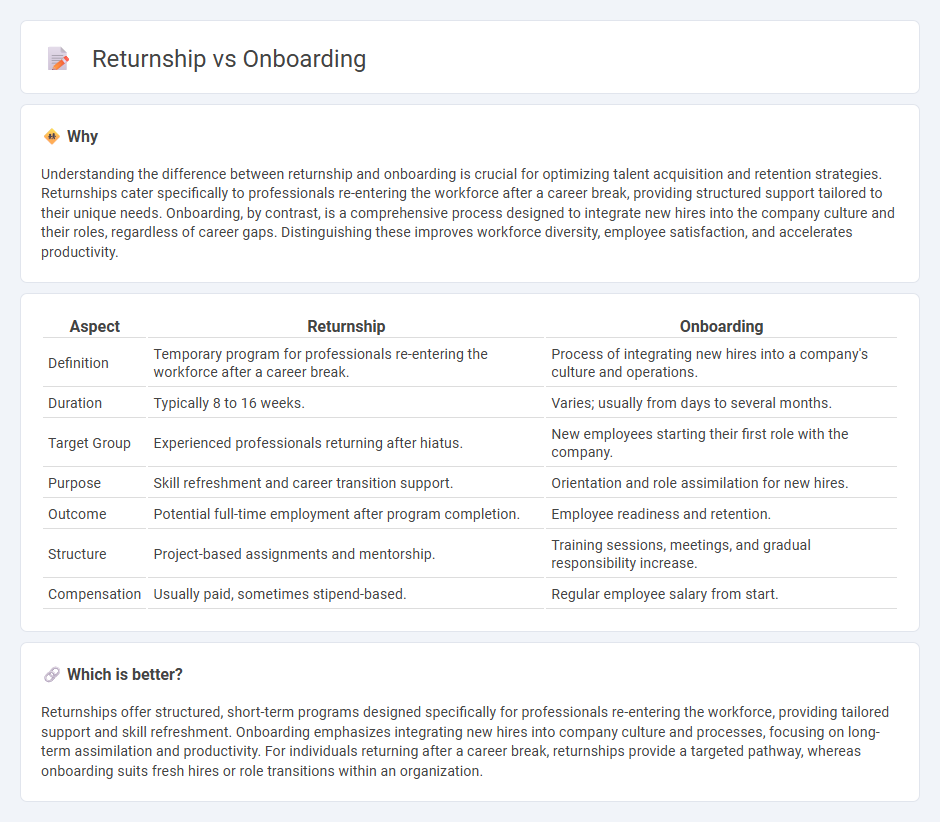
Returnships offer structured opportunities for professionals re-entering the workforce after a career break, focusing on skill refreshment and confidence building. Onboarding integrates new hires by familiarizing them with company culture, processes, and expectations to ensure smooth assimilation. Explore how these programs enhance workforce readiness and retention strategies.
Why it is important
Understanding the difference between returnship and onboarding is crucial for optimizing talent acquisition and retention strategies. Returnships cater specifically to professionals re-entering the workforce after a career break, providing structured support tailored to their unique needs. Onboarding, by contrast, is a comprehensive process designed to integrate new hires into the company culture and their roles, regardless of career gaps. Distinguishing these improves workforce diversity, employee satisfaction, and accelerates productivity.
Comparison Table
| Aspect | Returnship | Onboarding |
|---|---|---|
| Definition | Temporary program for professionals re-entering the workforce after a career break. | Process of integrating new hires into a company's culture and operations. |
| Duration | Typically 8 to 16 weeks. | Varies; usually from days to several months. |
| Target Group | Experienced professionals returning after hiatus. | New employees starting their first role with the company. |
| Purpose | Skill refreshment and career transition support. | Orientation and role assimilation for new hires. |
| Outcome | Potential full-time employment after program completion. | Employee readiness and retention. |
| Structure | Project-based assignments and mentorship. | Training sessions, meetings, and gradual responsibility increase. |
| Compensation | Usually paid, sometimes stipend-based. | Regular employee salary from start. |
Which is better?
Returnships offer structured, short-term programs designed specifically for professionals re-entering the workforce, providing tailored support and skill refreshment. Onboarding emphasizes integrating new hires into company culture and processes, focusing on long-term assimilation and productivity. For individuals returning after a career break, returnships provide a targeted pathway, whereas onboarding suits fresh hires or role transitions within an organization.
Connection
Returnship programs accelerate workforce reintegration by providing structured onboarding that familiarizes returning employees with updated company policies, technology, and team dynamics. Effective onboarding in returnships enhances skill reacquisition and confidence, reducing the time needed to achieve full productivity. Companies leveraging returnship onboarding report higher retention rates and improved employee engagement among experienced professionals re-entering the labor market.
Key Terms
**Onboarding:**
Onboarding is a structured process designed to integrate new employees into a company by providing essential training, resources, and socialization to ensure smooth adaptation and productivity. It includes activities such as orientation sessions, mentorship programs, and compliance training that align new hires with organizational culture and expectations. Discover more about optimizing onboarding strategies to enhance employee retention and performance.
Orientation
Onboarding programs focus on integrating new employees by providing comprehensive orientation sessions, company culture immersion, and role-specific training to ensure a smooth transition. Returnship programs tailor orientation for professionals re-entering the workforce, emphasizing updated skills, flexible schedules, and confidence-building activities to bridge career gaps. Discover more effective orientation strategies to enhance both onboarding and returnship experiences.
Training
Onboarding programs emphasize comprehensive training tailored to new employees, ensuring they quickly acquire necessary skills and company knowledge. Returnship initiatives concentrate on reskilling and upskilling professionals reentering the workforce, often providing targeted training to bridge gaps from career breaks. Discover how specialized training approaches in onboarding and returnship enhance workforce integration and productivity.
Source and External Links
Complete Employee Onboarding Guide - Onboarding is the process of integrating new employees into an organization by familiarizing them with company culture, structure, and policies, often including orientation, mentorship, and innovative engagement practices.
What Is Onboarding? (Definition, Process, Examples) - Onboarding involves steps like welcoming communication, access to tools, team introductions, and ongoing check-ins to support new hires, improving retention and productivity.
What Are The 4Cs of Onboarding and How to Implement ... - Effective onboarding follows the 4Cs framework: Compliance, Clarification, Culture, and Connection to help new employees understand expectations, company values, and build relationships.
 dowidth.com
dowidth.com